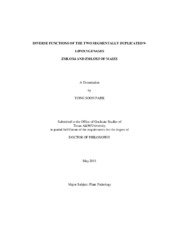| dc.description.abstract | Plant lipoxygenases (LOX) are non-heme iron containing dioxygenases that catalyze the hydroperoxidation of polyunsaturated fatty acids resulting in the synthesis of a large number of functionally diverse oxylipins. Although the physiological functions of jasmonate-producing 13-LOXs in dicots have been reported and highlighted in host defenses to pathogens and insects, the functions of 9-LOXs and 9-LOX derived oxylipins remain obscure for both monocots and dicots. The objective of this study was to elucidate the biochemical, molecular and physiological roles of a segmentaly duplicated pair of 9-LOXs, ZmLOX4 and ZmLOX5, in host defenses to diverse stresses. Despite of their extreme similarities at the sequence levels, the ZmLOX4 was preferentially expressed in underground organs, whereas ZmLOX5 was stress-induced in aboveground organs. Both genes were highly induced by exogenous jasmonic acid (JA) but transcripts of ZmLOX5 only were strongly induced in wounded leaves as well as in response to insect infestation, suggesting the role of ZmLOX5 in plant resistance response against insect herbivory. To test potential function of ZmLOX4 and ZmLOX5, near-isogenic wild-type and mutants were generated. In this study, I provided genetic evidence that ZmLOX5 is involved in host defense against insect herbivores via the regulation of wound-induced JA biosynthesis. Contrary to the role in insect defenses, ZmLOX5 mediated metabolism contributes to enhanced susceptibility to a leaf fungal pathogen, Colletotricum graminicola. ZmLOX4 appears to have evolved a defense function against C. graminicola. In addition, lox4 and lox5 mutants have opposite phenotypes in their ability to support production of conidia and to facilitate colonization of kernels in response to Aspergillus flavus. However, the two mutants were similar to each other in their enhanced susceptibility to kernel colonization and conidia production of Fusarium verticillioides. In conclusion, the data suggest that these two 9-LOXs, ZmLOX4 and ZmLOX5 and their metabolites have distinct roles in plant-insect and plant-pathogen interactions. | en |


